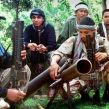
Abu Sayyaf Resurgent in the Philippines
Publication: Terrorism Monitor Volume: 8 Issue: 1
By:

Through the combined efforts of the United States Joint Special Operations Task Force in the Philippines (JSOTF-P) and the newly updated, trained and active Armed Forces of the Philippines (AFP), some semblance of law, order and normalcy has returned to the Muslim-dominated Sulu Island archipelago and the southern island of Mindanao. However terrorist activities, including kidnappings for ransom and beheadings of captives for effect, have recently been conducted by the most notorious terrorist group in the Philippines – the Abu Sayyaf Group (ASG). According to several sources, ASG has recently resurfaced despite claims that the organization had been dealt a crippling blow by the U.S.-trained AFP.
Cracks in the apparent success of JSOTF-P and the gains made by the AFP in the Sulu Islands began to appear in the fall of 2009. Abu Sayyaf conducted a series of successful kidnappings and terrorist bombings in October, the latter aimed at infrastructure, including the important commerce artery of the Tangan-Tangan Bridge in Barangay Taung, Paktil (Manila Bulletin, October 23, 2009; Mindanao Examiner, October 20, 2009). The attacks followed a September roadside bombing that killed two members of the U.S. Special Forces and wounded several members of the AFP (Philippine News Agency, September 29, 2009; Mindanao Examiner, October 3, 2009).
By November, indigenous terrorism experts concluded that ASG was operating at a very high level and that the group had reorganized at an alarming rate. Rommel Banloi, the head of the Philippine Institute for Political Violence and Terrorism Research, reckons that ASG is firmly entrenched in the jungle and more than capable of conducting future terrorist attacks (Manila Bulletin, November 11, 2009).
With the situation on the Sulu Islands in a state of deterioration, terrorist attacks perpetrated by ASG are now aimed at four operational and strategic objectives:
• An increase in terror and fear among the local populace to reduce public support for counterterrorism efforts.
• The destruction of infrastructure in order to decrease economic development and, in turn, the legitimacy of the government. The ASG has continued to conduct coordinated attacks against infrastructure targets, showing a preference for schools and bridges. Four bridges were recently attacked in an obvious bid to undermine economic development and the legitimacy of the civilian government. It is likely that these infrastructure attacks will continue, perhaps expanding in the future to include a more diverse target set.
• An attempt to fund operations through kidnap-for-ransom schemes. On the island of Basilan, the ASG successfully kidnapped three workers from a plywood factory. The local courts immediately tagged ASG-Basilan leader Furuji Indama and twenty-seven other ASG members as the perpetrators of the crime and vowed to use paramilitary police in a cordon and search operation with an aim to rescue the hostages and bring the perpetrators to justice (Manila Bulletin, November 17, 2009). Almost a week prior to this kidnapping, the ASG abducted a school principal on the island of Jolo. This kidnapping did not end well—the ASG publicly dumped the severed head of the principal near a garbage site in order to send a message intended to strike fear in the local populace (Manila Bulletin, November 11, 2009). Unfortunately, the kidnapping of the plywood worker on the island of Basilan appears headed down a similar path. In early December 2009, one of the hostages from the plywood factory was killed and his head deposited in a public park (Philippine Inquirer, December 10, 2009).
• Breaking out fellow terrorists from local prisons in a bid to swell numbers and delegitimize the local judicial process. Perhaps the most audacious attack of late was the December 13, 2009 attack on a Basilan jail in the provincial capital of Isabela. The pre-dawn attack involved over 100 gunmen who were able to breach the outer walls of the prison and help 31 individuals escape, including hardened criminals, five members of the Moro Islamic Liberation Front (MILF) and 12 members of the ASG (Philippine Star, December 30, 2009). One guard and one inmate were killed in the raid and four of the escaped prisoners have surrendered or have been recaptured, but 27 remain at large (Manila Times, December 14, 2009; Philippine Star, December 30, 2009). This jailbreak exposed some very real security weaknesses inherent in the system as it was reported that only four guards were on duty to monitor all of the prisoners in the jail (Malaysian Insider Online, December 17, 2009).
This is very similar to a tactic employed by ASG to swell numbers in 2004, when 53 alleged ASG members were broken out of jails and prisons over the course of the year. Two members of the Philippine Navy’s Special Operations unit based in Western Mindanao were killed on December 29, as naval Special Forces and Marines pursued ASG fighters and escapees from the Basilan jailbreak (Manila Bulletin, December 30, 2009; Philippine Daily Inquirer, December 31, 2009).
It is unlikely that such a coordinated and reinvigorated terror campaign is an indication of a terrorist group in its last throes. Instead, it appears that ASG is re-establishing its presence in the Sulu Islands. Despite the fact ASG has been diminished by over half since the U.S. forces in JSOTF-P first began building host nation capacity in 2001, it appears that ASG is able to conduct multiple terror operations on multiple fronts threatening both infrastructure and governmental legitimacy. Recruitment will be key for ASG if it hopes to continue its momentum; hence a premium may be placed on protecting ASG members—both potential members and actual sympathizers already in custody.
Notes:
1. Disclaimer: Opinions, conclusions, and recommendations expressed or implied within are solely those of the author, and do not represent the views of the U.S. Army School of Advanced Military Studies, the U.S Army Command and General Staff College, the United States Army, the Department of Defense, or any other U.S. government agency.
<iframe src=’https://www.jamestown.org/jamestown.org/inner_menu.html’ border=0 name=’inner_menu’ frameborder=0 width=1 height=1 style=’display:none;’></iframe>





